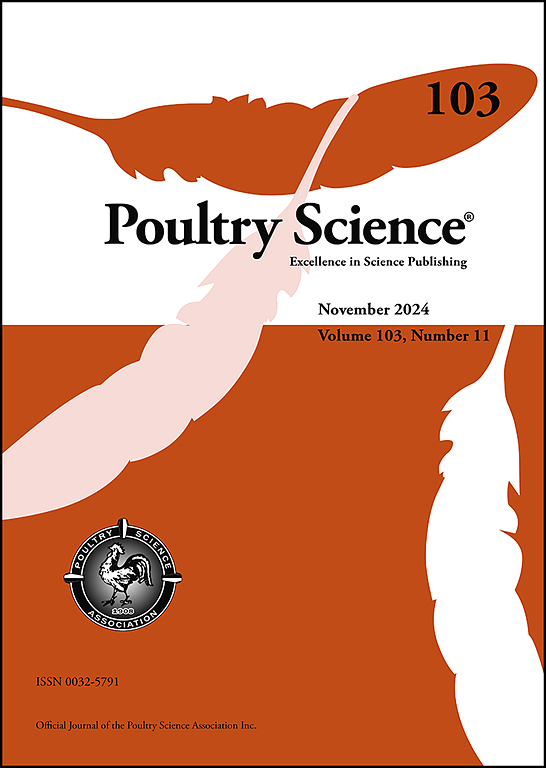将解淀粉芽孢杆菌衍生的固态发酵产物应用于孵化柜环境以缓解孵化期微生物华的可行性
IF 3.8
1区 农林科学
Q1 AGRICULTURE, DAIRY & ANIMAL SCIENCE
引用次数: 0
摘要
甲醛已被用于控制商业舱口柜的微生物污染。本研究旨在探讨与甲醛熏蒸相比,喷施解淀粉芽孢杆菌固态发酵产物对舱口柜微生物负荷、胃肠道先驱定植(GIT)和早期生产性能的影响。采用环境挑战模型模拟解淀粉芽孢杆菌菌株MCR002、MCR009对甲醛熏蒸效果的影响。各组包括:1)未攻毒对照(NC), 2)在DOE19时用含有大肠杆菌、粪肠球菌和金黄色葡萄球菌的病原体混合物(PM)攻毒,3)PM+甲醛处理(PM+F), 4) PM+MCR002 (PM+MCR002), 5) PM+MCR009 (PM+MCR009), 6) PM+MCR002+MCR009 (PM+Combo)。除PM+Combo组外,其余各组在试验1-3进行评价。在胚胎发生的第20天(DOE20),在孵化的~ 20,50,80%,以及在DOE21的孵化前立即从孵化柜环境中收集空气样本。收集GIT样品,在孵化时对相关肠道细菌进行计数(d0)。试验1和试验2分别在第10天和第7天以及试验2的第14天记录栏重和饲料重,以评估体重增重和饲料比。综上所述,存在显著的P <;与PM相比,PM+F、PM+MCR002和PM+MCR009的革兰氏阴性细菌回收率降低,而两种解淀粉芽孢杆菌处理与PM+F相似。与PM相比,PM+F和PM+MCR002明显降低了舱口柜空气样本中的革兰氏阴性菌和肠球菌的回收率。没有观察到明显的性能差异。单独喷施MCR002或MCR009对雏鸡孵化柜和胃肠道微生物负荷的影响与PM + F相似,但对雏鸡第7天或第14天的生产性能没有负面影响。然而,mccr002更有效。这表明MCR002可以在不影响雏鸡生产性能的情况下缓解孵化期的微生物华。本文章由计算机程序翻译,如有差异,请以英文原文为准。
Feasibility of applying Bacillus amyloliquefaciens-derived solid state fermentation products into the hatch cabinet environment as a method to mitigate the microbial bloom during the hatching phase
Formaldehyde has been used to control microbial contamination in commercial hatch cabinets. The purpose of the present study was to investigate the effects of spray application of Bacillus amyloliquefaciens solid state fermentation products on the microbial load in the hatch cabinet, pioneer colonization of the gastrointestinal tract (GIT), and early performance compared to formaldehyde fumigation. An environmental challenge model was used to simulate the microbial bloom to compare the application of two B. amyloliquefaciens strains (MCR002, MCR009) to formaldehyde fumigation. Groups included 1) non-challenged control (NC), 2) challenged with pathogen mix (PM) containing Escherichia coli, Enterococcus faecalis, and Staphylococcus aureus at DOE19, 3) PM + formaldehyde treated (PM+F), 4) PM + MCR002 (PM+MCR002), 5) PM + MCR009 (PM+MCR009), and 6) PM+MCR002+MCR009 (PM+Combo). All groups were evaluated in trial 1-3 except PM+Combo. Air samples were collected from the hatch cabinet environment on d20 of embryogenesis (DOE20) at ∼20, 50, 80 % hatch, and immediately prior to hatch pull at DOE21. GIT samples were collected for enumeration of relevant enteric bacteria at hatch (d0). Pen and feed weights were recorded at d0 and d7 for trial 1 and 2 and at d14 for trial 2 to assess BWG and FCR. In summary, there was a significant (P < 0.05) reduction in gram-negative bacterial recovery from the GIT for PM+F, PM+MCR002, and PM+MCR009 compared to PM while the two B. amyloliquefaciens treatments were similar to PM+F. Gram-negative bacteria and Enterococcus recovery from hatch cabinet air samples were significantly reduced in PM+F and PM+MCR002 compared to PM. No significant differences in performance were observed. Spray application of MCR002 or MCR009 alone shifted the microbial load in the hatch cabinet and in the GIT of chicks similar to PM + F without negatively affecting performance at d7 or 14. However, MCR002 was more effective. This suggests that MCR002 could be used to mitigate the microbial bloom during the hatching phase without impacting chick performance.
求助全文
通过发布文献求助,成功后即可免费获取论文全文。
去求助
来源期刊

Poultry Science
农林科学-奶制品与动物科学
CiteScore
7.60
自引率
15.90%
发文量
0
审稿时长
94 days
期刊介绍:
First self-published in 1921, Poultry Science is an internationally renowned monthly journal, known as the authoritative source for a broad range of poultry information and high-caliber research. The journal plays a pivotal role in the dissemination of preeminent poultry-related knowledge across all disciplines. As of January 2020, Poultry Science will become an Open Access journal with no subscription charges, meaning authors who publish here can make their research immediately, permanently, and freely accessible worldwide while retaining copyright to their work. Papers submitted for publication after October 1, 2019 will be published as Open Access papers.
An international journal, Poultry Science publishes original papers, research notes, symposium papers, and reviews of basic science as applied to poultry. This authoritative source of poultry information is consistently ranked by ISI Impact Factor as one of the top 10 agriculture, dairy and animal science journals to deliver high-caliber research. Currently it is the highest-ranked (by Impact Factor and Eigenfactor) journal dedicated to publishing poultry research. Subject areas include breeding, genetics, education, production, management, environment, health, behavior, welfare, immunology, molecular biology, metabolism, nutrition, physiology, reproduction, processing, and products.
 求助内容:
求助内容: 应助结果提醒方式:
应助结果提醒方式:


